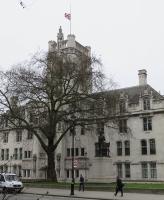

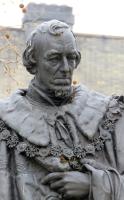
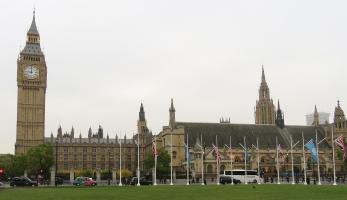

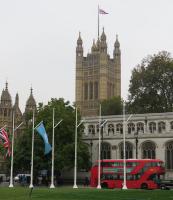
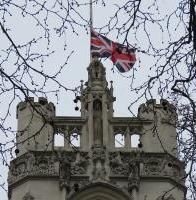
There are rather a lot of statues of great men – no women just yet – in Parliament Square, generally the earliest of which are of the most merit, and the later ones mostly of interest as portraits of statesmen rather than their sculptural qualities. The square is an iconic site, with the Houses of Parliament and especially Big Ben on the one side, the side of Westminster Abbey and St Margaret’s Church at right angles, the former Middlesex Guildhall, now the Supreme Court, facing the Houses of Parliament, and the Treasury Buildings on the north side adjacent to Whitehall. Because both the Houses of Parliament and Westminster Abbey stretch out past the end of the Square, there is an extended space with more statues adjacent, but these are not covered on this page. Naturally, the statues are primarily of statesmen. A variety of views are shown here; click to enlarge in the usual fashion.
George Canning statue by Sir Richard Westmacott RA.
But we start with Parliament Square proper. Best of all the statues is that of George Canning, on the outside of the Square by the Royal Institute of Engineering., best seen from across the traffic lights on the north side of the Square. Canning is depicted standing in easy pose, one hand on hip, the other holding a scroll, and although we see one closely trousered leg and his modern, laced shoes, his generous wrapping of drapery and vast cloak mean that essentially we have here a Classical statue, a civic orator in the style of Imperial Rome. The profile view of the head, especially in profile, is most noble. Sir Richard Westmacott RA was the sculptor, and this statue shows why he was so highly regarded. The statue dates from 1832, and it is thus the oldest in Parliament Square - the woodcut above right dates from just a few years after it was put up.
Sir Robert Peel statue by Matthew Noble.
Sir Robert Peel is next, dating from 1851, the work of the sculptor Matthew Noble. He has rather a simplified attire, again contemporary, with behind him a pillar with his discarded cloak upon it, as if the support for a statue of marble. The saving grace of this statue is the head, with its determined expression and clear gaze, and the characterful hands.
Lord Derby statue by Matthew Noble.
Lord Derby (Edward Smith-Stanley, 14th Earl of Derby), dating from 1874, is again by Matthew Noble. He is wearing contemporary costume, which to today’s eyes is better above, with broad shoulders and coat with heavy sleeves, than below, with the tight trousers and slipperlike shoes. His bushy beard and sideburns give a leonine nobility to his portrait, but the tall, upturned collar make him rather strange to the modern eye. He too holds some scroll, his other hand being palm-forward in an expansive gesture. A heavy cloak behind, to the sides and over one arm gives a massiveness and dignity to the statue, and keeps something of a semi-Classical look.
Panels to Lord Derby statue, by Horace Montford.
The base of the statue is a tall plinth of red granite, and bears four bronze panels around it, with high relief scenes from the Earl of Derby’s career; the sculptor of these was not Noble, but Horace Montford, who was his studio assistant at the time. The titles of the panels, in order, are: House of Commons, 1833; Chancellor of the University, Oxford, 1853; The Central Executive Cotton Famine Relief Committee, 1865; Cabinet Council, 1867. You will need to click on the images to enlarge them to appreciate the detail; one such detail is above, far right.
Viscount Palmerston statue by Thomas Woolner.
Viscount Palmerston is by Thomas Woolner, the Pre-Raphaelite sculptor, and is typical of the understated but characterful works of that artist. There is a mass and solidity to the figure, in buttoned short coat, and a grace to the pose, with the slightest of contrapuncto stances, weight on his right leg (left as we look at him), and angle to the upper body. He carries a short outer mantle, more a drape, over one lower arm, giving weight to that side, and his other hand is forward and open. The date of this statue is 1876.
Disraeli, Earl of Beaconsfield, statue by Mario Raggi.
Next Benjamin Disraeli, Earl of Beaconsfield, dating from 1883, by the Italian sculptor Mario Raggi. With his saturnine elegance and intelligent visage, he was the perfect subject for sculpture. Compositionally, the figure is better than the Earl of Derby, with less made of the modern dress by virtue of more being made of his cloak, which sweeps round in elegant curves, to be held over his arm and thence hanging down again – the view from the left hand side is particularly good. His lined face, all forehead and thick eyebrows above deep eyes, strong nose and bearded chin, peers down from above his wide ermine-cloaked shoulders and chain of office; as well as the characterful portrait, much is made by the sculptor of his hands. Mario Raggi, the sculptor, is also known for his portrait statue of Disraeli’s great rival as Prime Minister, Gladstone, in Albert Square, Manchester, as well as other works in Wales, and a seated Queen Victoria for Hong Kong. Disraeli's favourite flower was the Primrose, and he was associated with the Primrose League which spread Conservative ideals - the statue was bedecked with primroses on the anniversary of Disraeli's death each year (Primrose day), as shown in the picture above far right.
Abraham Lincoln statue, by Saint-Gaudens.
The statue of Abraham Lincoln, the splendid gift of the American People to the British People in 1921, is a reproduction of the famous statue of Lincoln at Chicago, dating from 1887, by the sculptor Augustus Saint-Gaudens. He is shown standing as if just raised from his grand chair, which is behind him, head down in serious contemplation. He wears contemporary dress, with waistcoat, trousers, and knee-length coat: no hearkening back to the Classical civic statue here. As the figure is tall and thin, the chair behind has an important compositional impact in bulking up and making the statue more imposing. As stated in the Architectural Review, the statue, ‘while not pretending to be an exact likeness, expresses very strikingly the popular conception of Lincoln’s character’. It looks particularly good from three-quarters view, when the spread-winged eagle on the chair can be seen too. There was another Lincoln statue offered to Britain, and accepted, which is the rather strange, gaunt one by George Gray Barnard – that one went to Manchester (see this page).
Jan Smuts statue by Jacob Epstein.
The statue of Jan Smuts dates from 1956, and he was Prime Minister of South Africa during World War II - Churchill had asked for his statue to be erected here. The statue is noticeable by virtue of the tipping-forward pose in the profile view. From the front, the leaning is of course less noticeable. The details are good – the aged face, the restless surface of the military uniform, but it is the oddness of pose that stands out. The sculptor was no less an artist than Jacob Epstein, well known for then-controversial works, including the much damaged architectural sculpture on no.429, the Strand (see this page), and many characterful portrait busts. So for the Smuts statue, concentrate on the head.
Winston Churchill statue by Ivor Roberts-Jones.
Winston Churchill, dating from as late as 1973. The best view is from the side, where the hulking back and massiveness of the statue can be appreciated, really one of the familiar images of going round Parliament Square on a double decker bus, and as close as the Square can get to an iconic statue, though it does not qute make my personal list (see this page). The scale really is quite large, twice the height of a tall man. Churchill is shown in an oversized coat, leaning a little sideways on a stick, and in the fashion of much modern sculpture, there is detail to the portrait head, and the visible hand, and the rest is impressionistic and with little detail. The sculptor was Ivor Roberts-Jones, and this is his most important work. He is also responsible for the Viscount Slim statue by the Ministry of Defence in Whitehall, not a good thing, and a twisted statue of Augustus John, the painter, in his home town of Fordingbridge, Hants.
The really modern statues, which stray beyond the interests of this website, are David Lloyd George, Nelson Mandela and Mahatma Gandhi. The latter two are low down rather than on high plinths, on the grounds that 'they should not be raised above the people on pedestals’, though unlike most people, they do merit bronze statues.
Lloyd George statue by Glynn Williams.
David Lloyd George, or as it might be termed, ‘Lloyd George in full flight’, is the first of these. The feature here is the wildly flapping cloak, splayed out to one side, which catches the eye from a distance. Close up, the emblematic simplicity of the statue, with little sense of anatomy or shape beneath the surface, makes it compare poorly to the earlier works. Glynn Williams was the sculptor and the date is 2007.
Nelson Mandela statue by Ian Walters.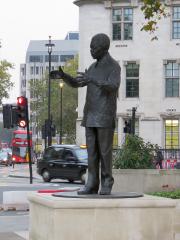
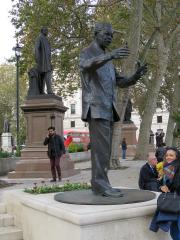
The statue of Nelson Mandela, also from 2007, to my eyes compares poorly with the earlier statues in the Square. There is no hint of the ‘natural human conviction that a public monument... should be, above all things, monumental’. Surely a statesman of such repute merits a better treatment than this, with the head and hands feeling a little too large for the body and jarring the eye, and an opportunity missed with the clothing to add drama and movement. The sculptor was Ian Walters, who did better things with his statue of Harold Wilson for Huddersfield.
Gandhi statue by Philip Jackson.
The most recent statue in Parliament Square is that of Gandhi, put up in 2015. He is bare-legged, wrapped in a short cloak, giving him a rather top-heavy appearance, and the portrait, very good around the eyes, even though unusually for a statue, he wears glasses, has a lack around the mouth. The sculptor was Philip Jackson. Fair, but I think it rather suffers by comparison with the seated figure of Gandhi in Tavistock Square.
We have to return now to the architectural sculpture facing onto the Square: the beautiful figures on the façade of the Supreme Court, formerly the Middlesex Guildhall. The principle façade around the portico contains a central frieze above the door, a statue to either side in a niche, and then two longer friezes, left and right. The central frieze shows Henry III on the left granting a charter to Westminster Abbey, attended by various functionaries and with the Archbishop to the right. The longer frieze on the left hand side shows King John at Runnymede signing Magna Carta, with the assembled barons. The other side, to the right, centres on a courtly lady being offered a crown by a kneeling man: it is Lady Jane Grey, and the kneeler is apparently the Duke of Northumberland, her father in law.
Middlesex Guildhall sculpture, by H.C. Fehr.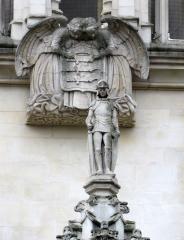
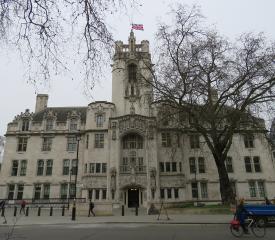
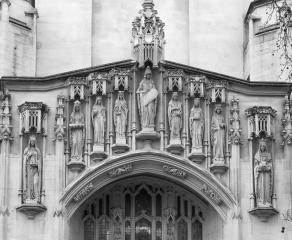
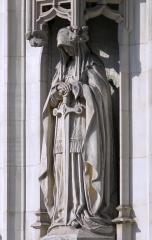
Up above is a medieval-style rank of seven female figures, all in niches, with two more to the sides, and on top of the central point, less easily seen, is a St George, and a pair of standing angels. Higher up heraldic detail on the tower is mostly lost behind the trees (see top of page).
Further along, we have a series of little angels, and bigger ones round the side facing Westminster Abbey, all very beautiful. H.C. Fehr was the gifted sculptor of all these, and surely these are the most excellent works of art in Parliament Square, from a purely artistic point of view.
And we have one more statue to mention: not quite within Parliament Square, but just about facing onto it from within the railings of the Houses of Parliament: Oliver Cromwell, dating from 1899, by Hamo Thornycroft. He stands looking downwards, serious and careworn, on hand on a book, the other on the pommel of his downward-pointing sword. All Thornycroft’s works are good, and this is no exception. On the plinth below is a lion: an excellent beast and it is a shame it is seen behind bars. If you like lion sculpture, see this page).
Cromwell statue by Hamo Thornycroft.
Further statues and sculpture is just off Parliament Square: the rest of the Houses of Parliament and the multitudinous statues of kings upon it; the Boadicea in her Chariot group by Westminster Bridge; and the Broad Sanctuary sculpture including the front of Westminster Abbey (see the walk on this page).
Boadicea statue, Westminster Bridge // North along Whitehall // Other London sculpture
Visits to this page from 1 Nov 2016: 2,882 since eptember 2024